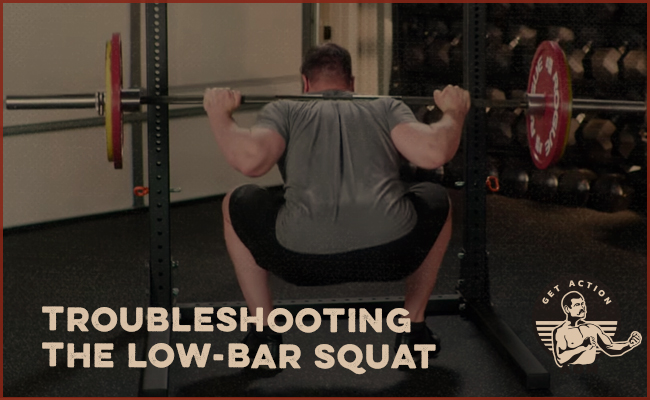
The squat is one of the most basic human movements and calls upon the body’s largest muscles, including your glutes, hamstrings, and quads. There are different variations of the squat, but in barbell training, two types are the most common: the high-bar squat and the low-bar squat.
Which one you choose will depend on your strength-training goals. I’m a fan of the low-bar squat since it works more muscles in the posterior chain, i.e., the “chain” of muscles that run up the back of the body. More muscle utilization = more weight moved. What’s more, because the low-bar squat requires you to bend over during the squat, you’ll also be working your lower back muscles.
While the low-bar squat can get you strong, it’s not an intuitive way to squat. Consequently, there are a few places during the lift where you can mess it up, resulting in an inefficient squat at best, and an injury at worst.
If you’ve been experiencing awkwardness and pain with the low-bar squat, Matt Reynolds, my strength coach and the owner of Barbell Logic, walks us through the issues that may be to blame, and how to troubleshoot this fundamental lift in order to perform it more safely and efficiently.
Low-Bar Squat Problem: Pain in the Wrist, Elbow, and/or Forearm
Solution: Fix Your Setup
“When people first start low-bar squatting,” Matt says, “they’ll often report having wrist, elbow, or forearm pain after they squat.”
The reason? “They’re setting up for the low-bar squat incorrectly.”
According to Matt, faulty setup is the most common problem people have with the low-bar squat. That’s because getting into the correct position is inherently uncomfortable: the low-bar squat setup requires you to get your shoulders, back, and chest really tight. This tightness creates a shelf of muscle between your traps and rear delts that will hold the bar in place. Maintaining that tightness throughout a set of squats can get tiring, so people loosen up. But that’s when the problems start, according to Matt.
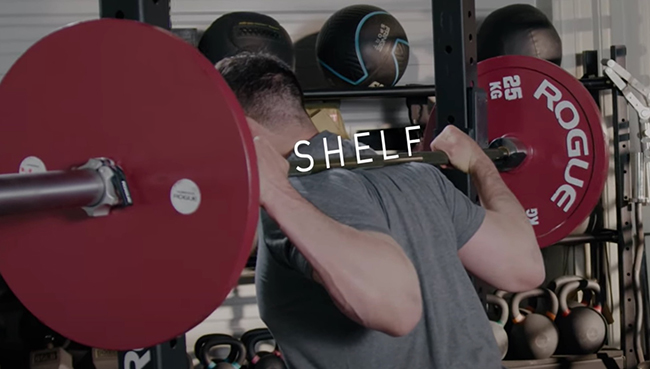
“When you loosen up your shoulders and take your upper back out of extension, the squat feels more comfortable, but in the process of getting comfortable, you’ve eliminated that shelf of muscle that was holding the bar on your back. To keep the bar on your back, your hands have to hold the weight. And this is where the wrist/forearm/elbow pain starts.”
Having your arms try to keep 300 pounds of weight on your back is a recipe for injury. You have to either hold your wrists in extension (bent back) or flexion (bent forward) to keep the bar in place. While the muscles in your arms have the strength to do this, the tendons in your arms won’t be happy about it. They’ll get cranky from the overuse and develop tendonitis, which can set your training back for days or even months.

Wrist extension. Wrong
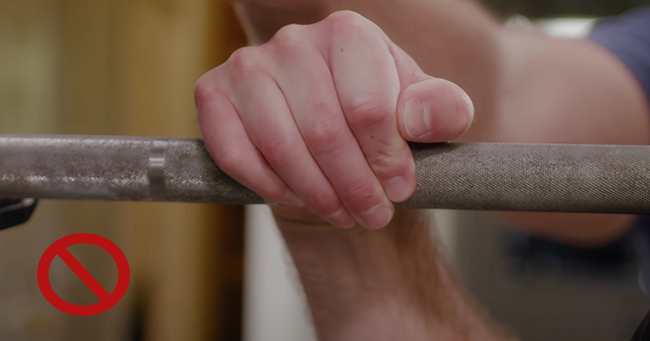
Wrist flexion. Wrong.
So how do you correct the setup problem?
Get back to basics and make sure your bar is in a secure position, and you’re taking a correct grip on it. Use the spine of the scapula as a marker for the top of your muscle shelf. Use as narrow a grip as possible, while maintaining neutral wrists throughout the lift — don’t flex or extend them. Lift up your chest to extend your upper back. During the lift, think “pin arms to sides.” This will help keep your wrists in a neutral position throughout the lift and keep your arms out of the lift. Doing all of these things together will ensure that the bar’s weight is just on your back.
If at any point during the lift you feel the weight in your hands, your setup is wrong. Start over from the beginning.
Getting into the low-bar setup is hard for a lot of people. It requires some flexibility in the shoulders. If you’ve been hunched over like a Quasimodo for years, and have trouble getting into the proper position, Matt recommends a couple things:
- Stretch your upper back and shoulders. Before every squat session, Matt recommends doing a stretching routine as laid out by strength coach Paul Horn. In addition to these pre-squat stretches, you can work on your upper back and shoulder flexibility with our “de-Quasimodo yourself” stretching routine.
- Put your thumbs around the bar. The traditional low-bar squat calls for taking a grip with thumbs on top of the bar. “Some people just can’t get in the proper setup with thumbs on top of the bar because they lack the flexibility in their shoulders or they have really long forearms compared to their upper arm,” Matt says. “And that’s fine. Putting your thumb around the bar [instead] can help you get into that neutral wrist position. As long as you don’t feel the weight of the bar in your hands, you’re fine.”
Try the stretches first. If, after a few weeks of stretching, you still can’t get into the proper low-bar squat setup, try putting your thumbs around the bar.
And if you’ve already got a bad case of tendonitis due to improper low-bar squat setup, make sure to check out our protocol on how to rehab bicep tendonitis.
Low-Bar Squat Problem: Lower Back Pain
Solution: Stop Rounding Your Back
If you’re experiencing pain in your back when you squat, something called “butt wink” may be to blame.
Matt explains butt wink as where “your butt tucks underneath you at the bottom of the squat. You look like a dog pooping in the woods.”
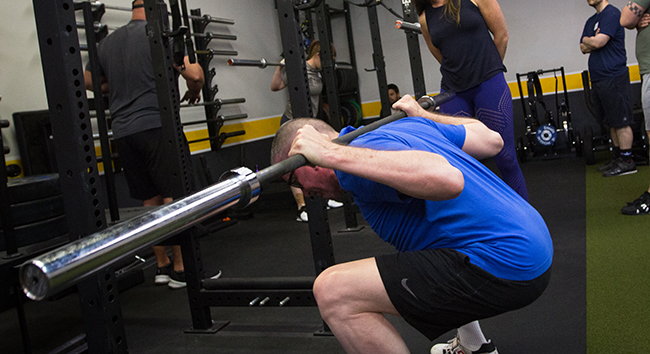
Example of butt wink, or lower back rounding.
Butt wink is related to the depth issue. It happens at the bottom of the squat because the lifter lets his lower back round. Lifters do this because 1) holding their lower back in extension at the bottom of the lift is uncomfortable, and 2) rounding their lower back allows them to hit depth more easily.
“Instead of getting the crease of your hip below the top of the knee while staying tight, rounding your lower back allows you to bend your way to depth,” Matt says.
The best cue to correct butt wink is “stay tight.” If that doesn’t work, Matt recommends a more crude cue: keep your butthole pointed at the wall behind you during the lift.
That cue worked for my 9-year-old son. Matt was coaching him on how to squat last week, and Gus was having trouble with butt wink. As soon as Matt said, “keep your butt pointed at the wall,” the butt wink disappeared.
Low-Bar Squat Problem: Pain in Your Hips
Solution: Stay Balanced Over Your Midfoot
If you sometimes feel like you might fall backwards as you squat, it’s likely you’re shifting too much of your weight towards your heels. “If you feel your toes come off the ground while you’re squatting, that’s not good,” Matt says. “That could cause some downstream problems, like hip pain, after a while.”
During a squat, your weight should stay balanced over the middle of your feet. Getting to this optimal position takes time and experience (here’s a good instructional for getting it down). “Your feet should feel like they’re glued to the floor throughout the squat. Think ‘push through the middle of my feet.’ That’s a cue a lot of people find helpful,” Matt says.
Low-Bar Squat Problem: Pain in Your Knees
Solution #1: Stay Balanced Over Your Midfoot
More common than shifting your weight to your heels, is shifting too much of your weight to your toes. “I see most people get up on the balls of their feet during the descent and ascent of the squat,” Matt observes. “This shifts the weight forward onto your knees, and the result is people complaining about squats hurting their knees.”
The solution here is the same as just discussed above: balance your weight over your midfoot. “You should feel weight all throughout your foot,” Matt advises.
Solution #2: Bend Over More
One reason you may be putting too much weight on your toes is the way you position your torso during the lift.
Unlike the high-bar squat, which calls for a vertical torso as you descend, the low-bar squat calls for the lifter to bend over. “This is scary for many people because it doesn’t feel natural,” Matt told me. “They typically want to try to maintain a vertical torso because they’re used to high-bar squatting.”
When you stay vertical during a low-bar squat, your knees tend to shift forward. When your knees shift forward, the bar moves forward. When the bar moves forward, your weight shifts to your toes, and you run into knee pain problems.
“When you bend over more than you think you should, your butt will go backward. When your butt goes backwards, it helps you keep the bar back over your midfoot, and use the muscles around the hips, like your hamstrings, glutes, and your adductors instead of putting all of the pressure on your knees,” Matt says.
Bottom line, as you perform the low-bar squat, bend over more than you think you need to.
Solution #3: Lead With Your Hips on the Way Up
Another reason you may be shifting too much weight to your toes lies in your hips (which themselves don’t lie).
The most common problem you see when people stand up on the squat is that they don’t lead with their hips. “Most people just want to get their chest up as soon as they can because they feel like they’re going to get folded in half because they’re bent over [so much],” Matt told me. “What ends up happening is that people sort of scoop their way up from the bottom of the squat. The hips shift forward, the knees shift forward, and the weight shifts forward, resulting in a less efficient lift and possible knee pain.”

To avoid that, think “hips first.” Drive your butt out of the bottom of the squat. Stay bent over most of the way up. Stand up with your chest once you’re about 75% of the way up.
As Matt observes, “Staying bent over is not only safer, but you’ll work more muscles in the process: your lower back, your glutes, your hamstrings, and your quads.”
Solution #4: Squat to Just Below Parallel
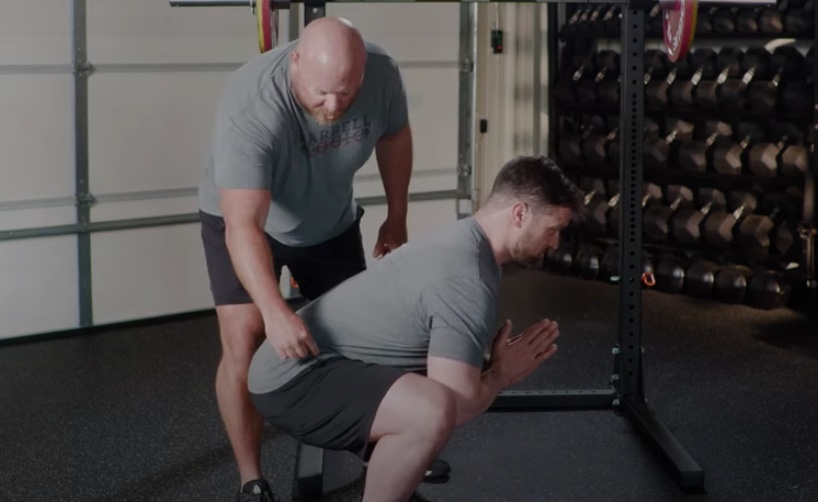
With squat depth, you don’t want to go too high or too low. You want to get it juuust right. And juuust right depth is just below parallel. You know if you’ve reached just below parallel on your squat if the crease of your shorts at the hip is ever so slightly below the top of your knee.
Hitting this just-below-parallel-depth is not only safest and easiest on the knees, it’s the most effective methodology, as it allows you to use the most muscle.
“The reason we squat to just below parallel,” Matt explains, “is that those giant muscle groups — the quads, the hamstrings, the glutes, and the adductors — are all stretched and working. If we squat above parallel, only the quads get stretched. All those other muscles don’t. So the hamstrings don’t get stretched, the glutes [don’t get stretched]. So you’re leaving all those large muscles off the table. They’re not able to contribute effectively to the squat.”
And if you go too far below parallel (also known as “ass to grass”), your hamstrings get loosened up, which takes them out of the lift.
Check your depth visually by videoing yourself, making sure the crease of your hip is just below the top of your knee, and making sure the bottom of your squat is in the tightest position possible by reaching your butt back. Too deep will usually feel more comfortable, and comfortable is wrong.
If you are still having trouble finding the correct depth, set up a depth marker. Use a low box or a stack of plates that reaches to about the top of your calves, around 12-14 inches high for most guys. Stand with the marker about 4-6 inches behind your heels in your normal squat stance — heels shoulder-width apart with toes out about 30 degrees. Squat down, reaching your hips back and lowering them down to the marker. Touch the marker without sitting on it, and pause without relaxing. Stand back up leading with your hips, and keeping your chest from collapsing forward. Check your depth with video and make adjustments to the height of your marker as necessary. Once you are comfortable hitting depth and staying tight, and have gotten a sense for what that feels like, you can add the bar and get rid of the depth marker.
Tags: Exercises

